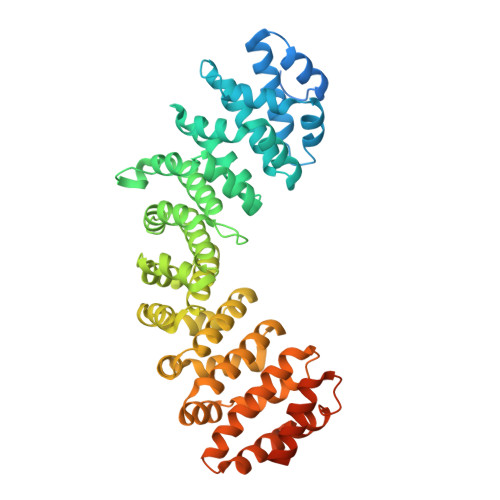Structural basis of nuclear import of flap endonuclease 1 (FEN1).
de Barros, A.C., Takeda, A.A., Chang, C.W., Kobe, B., Fontes, M.R.(2012) Acta Crystallogr D Biol Crystallogr 68: 743-750
- PubMed: 22751659
- DOI: https://doi.org/10.1107/S0907444912010281
- Primary Citation of Related Structures:
3UVU - PubMed Abstract:
Flap endonuclease 1 (FEN1) is a member of the nuclease family and is structurally conserved from bacteriophages to humans. This protein is involved in multiple DNA-processing pathways, including Okazaki fragment maturation, stalled replication-fork rescue, telomere maintenance, long-patch base-excision repair and apoptotic DNA fragmentation. FEN1 has three functional motifs that are responsible for its nuclease, PCNA-interaction and nuclear localization activities, respectively. It has been shown that the C-terminal nuclear localization sequence (NLS) facilitates nuclear localization of the enzyme during the S phase of the cell cycle and in response to DNA damage. To determine the structural basis of the recognition of FEN1 by the nuclear import receptor importin α, the crystal structure of the complex of importin α with a peptide corresponding to the FEN1 NLS was solved. Structural studies confirmed the binding of the FEN1 NLS as a classical bipartite NLS; however, in contrast to the previously proposed (354)KRKX(8)KKK(367) sequence, it is the (354)KRX(10)KKAK(369) sequence that binds to importin α. This result explains the incomplete inhibition of localization that was observed on mutating residues (365)KKK(367). Acidic and polar residues in the X(10) linker region close to the basic clusters play an important role in binding to importin α. These results suggest that the basic residues in the N-terminal basic cluster of bipartite NLSs may play roles that are more critical than those of the many basic residues in the C-terminal basic cluster.
Organizational Affiliation:
Departamento de Física e Biofísica, Instituto de Biociências, Universidade Estadual Paulista, Botucatu, SP 18618-970, Brazil.















